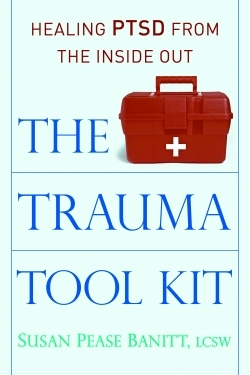The Trauma Took Kit
Healing PTSD From the Insdie Out
Post Traumatic Stress Disorder (PTSD) is a human event of such enormous repercussions that it envelops both mind and body. According to Susan Pease Banitt, in her book The Trauma Tool Kit: Healing PTSD From the Inside Out, “PTSD is a whole-body tragedy.”
Western medicine has traditionally treated psychological trauma as an issue of the mind and psyche. However, today it is becoming more understood that stress and trauma
affect the entire human organism, including
physical health.
Banitt encourages people who have been traumatized, whether they are returning soldiers, child-abuse survivors, or others in recovery from trauma, to realize the complexity of their experiences and work on their own rehabilitation. While she advocates working with professional therapists, and is a counselor herself, she also believes that the typical one hour per week with a therapist is not enough. So she has designed a “smorgasbord of healing techniques and tools” to help PTSD victims move the healing process along faster.
Tool #1 gives readers a “Roadmap for Healing from Trauma” that defines, explains, and acknowledges the many ways people can be traumatized, as in a natural disaster, accident, sudden life change, medical diagnosis, or abuse. It illustrates the stages of healing and advises, “Start where you are and keep moving forward.”
Another tool is called “First Aid for Psychological Trauma and Shock.” Practical interventions for these conditions are detailed and the focus is on ways to become grounded—breathing techniques, herbal remedies, warm salt baths, talking with someone, visualization, sleeping and meditation, prayer, a light diet, lots of water, and solitude.
Banitt writes from the perspective of both a traumatic stress therapist and as a person who has suffered from PTSD. Many of her chapters deal with alternative medical and psychological concepts and treatments developed in different regions, eras, and belief systems. She encourages readers to consider many different techniques for healing based on the divergent philosophies offered.
Tool #10 is “Embracing Wholeness: The Motivation to Heal.” With their toolboxes now brimming with advice, readers are encouraged to use this final array of healing tools in pursuit of wellness. Assurance is given that with awareness and a focus on getting well, wholeness is possible, and PTSD sufferers can go forward in life with a greater measure of joy and fulfillment.
Susan Pease Banitt, LCSW, is a Harvard-trained psychotherapist. She has studied alternative healing and shamanism for over twenty years.
Reviewed by
Penny Hastings
Disclosure: This article is not an endorsement, but a review. The publisher of this book provided free copies of the book to have their book reviewed by a professional reviewer. No fee was paid by the publisher for this review. Foreword Reviews only recommends books that we love. Foreword Magazine, Inc. is disclosing this in accordance with the Federal Trade Commission’s 16 CFR, Part 255.

